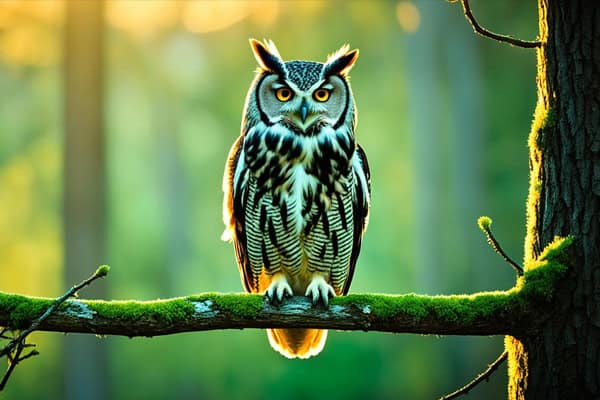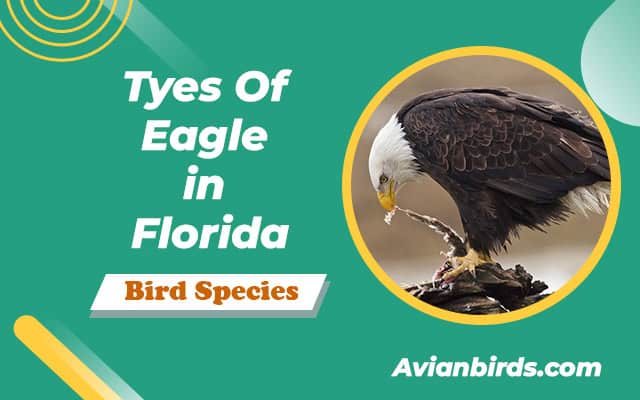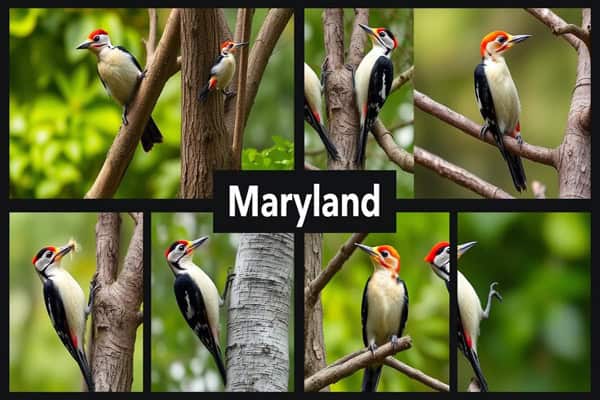8 Owls Species That Live in Indiana! (ID Guide)
Did you know Indiana has 8 different types of owls? In Indiana, we’re lucky to have eight owl species, like the Great Horned Owl and the Short-eared Owl. Each owl has unique traits and plays a big part in our ecosystem.
Let’s dive into the world of these amazing birds. We’ll learn about their habits and how they help nature. From the Barred Owl’s call to the Snowy Owl’s looks, there’s a lot to explore.
What Do Owls Sound Like?
Owls make different sounds, but they’re most famous for their hooting. This deep, echoing call is what many people recognize. However, owls can also screech, whistle, and even make hissing or clicking noises. The sounds they make depend on the species and what they want to communicate, such as warning others or calling for a mate. Each owl has its own unique voice, so no two owls sound exactly the same.
1. Great Horned Owl
- Scientific name: Bubo virginianus
- Life span: 25 – 50 years
- Size: 43 to 64 cm
- Weight: 1200 to 1600 g
- Wingspan: 91 to 153 cm
The Great Horned Owl is a well-known owl in North America. It’s famous for its unique look and hunting skills. Its tufts and striking features make it easy to identify.

Identification and Characteristics
These owls in Indiana are big, measuring 17 to 25 inches long, and having a wingspan of 3 to 5 feet. Its gray and brown feathers help it hide in different places. Its eyes are set deep, giving it amazing night vision for hunting at night.
Diet and Hunting Habits
The Great Horned Owl eats a wide variety of food, like rabbits, rodents, birds, and reptiles. They hunt with powerful talons, catching prey with surprise and speed. They can hunt in many places, making them successful in different environments.
Habitat and Range in Indiana
In Indiana, Great Horned Owls live in many places, such as forests, grasslands, and even cities. They need good places to nest and hunt. This makes them common sights in the state.
| Characteristic | Details |
|---|---|
| Length | 17 to 25 inches |
| Wingspan | 3 to 5 feet |
| Main Prey | Rabbits, rodents, birds, reptiles |
| Habitat | Forests, grasslands, urban areas |
| Nocturnal Behavior | Active primarily at night |
2. Short-eared Owl
- Scientific name: Asio flammeus
- Life span: 12 years
- Size: 34 to 43 cm
- Weight: 206 to 475 g
- Wingspan: 85 to 110 cm
The Short-eared Owl is a fascinating bird that birdwatchers love to see. It stands out with its mid-sized body and tawny-brown color. Its face has dark eye patches that make it easy to spot. This owl is special because it hunts during the day, especially at dawn and dusk.

Physical Appearance
The Short-eared Owl has earthy colors that help it blend into its surroundings. It has a unique shape and big, expressive eyes. These features make it very charming.
Nesting and Breeding Behavior
Short-eared Owls build their nests on the ground in open areas. They line the nest with grasses for safety. They are very protective of their young, using tricks to distract predators away from them.
Seeing a Short-eared Owl act like it’s hurt is amazing. It shows how smart they are at keeping their nests safe.
3. American Barn Owl
- Scientific name: Tyto furcata
- Life span: 10 years
- Size: 34 to 38 cm
- Weight: 400 to 600 g
- Wingspan: 29 to 36 cm
The American Barn Owl is a sight to behold with its beautiful looks and amazing hunting skills. It has a heart-shaped face and sandy-colored feathers. These features make it stand out from other owls.
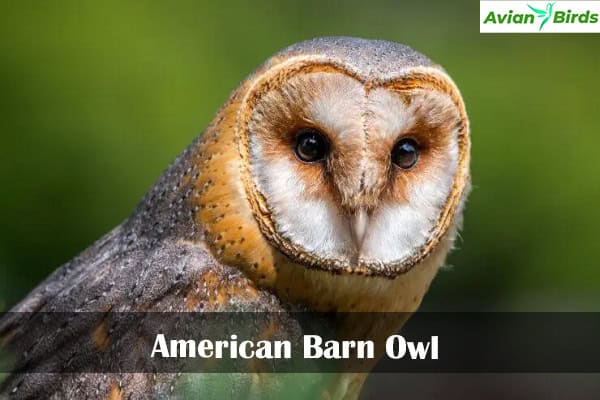
Its unique face helps it find prey even in thick plants or deep snow. This is why it’s so good at hunting.
Unique Features and Adaptations
The American Barn Owl has some cool adaptations. Its ears are not the same size, and its face has a special disc. These help it hear and see in the dark.
It can hear very quiet sounds and see well at night. This makes it a top hunter in the dark. It lives in places like grasslands and farms, where it hunts small animals.
Impact of Habitat on Population
Habitat loss is a big problem for the American Barn Owl. Cities and farms take over their homes, making it hard to find food. Pesticides also hurt their food supply and the owl population.
We need to work on fixing their homes and support farming that helps owls. This will make a big difference for these amazing birds.
4. Northern Saw-whet Owl
- Scientific name: Aegolius acadicus
- Life span: 7 to 17 years
- Size: 17 to 22 cm
- Weight: 54 to 151 g
- Wingspan: 42 to 56.3 cm
The Northern Saw-whet Owl is one of the smallest owls in Indiana. It stands between 6.5 to 9 inches tall. Its round head and streaked feathers help it blend into the wild.

Size and Appearance
This owl has a small size and a rounded body. Its feathers have streaked patterns that help it hide. These markings also make it look beautiful.
Its wide eyes and compact body make it very cute. People often find it charming when they see it.
Behavior and Vocalizations
The Northern Saw-whet Owl makes a unique two-note call at night. This call is important for finding a mate and defending its territory. At night, it hunts small mammals and insects with skill.
It’s a secretive bird, making it hard to spot. This adds to its mystery and charm in the wild.
Owls in other Regions:
5. Barred Owl
- Scientific name: Strix varia
- Life span: 8 years
- Size: 40 to 63 cm
- Weight: 610 to 1,150 g
- Wingspan: 96 to 125 cm
The Barred Owl is a well-known owl in North America, thanks to its unique sounds. We often hear their calls in Indiana’s woods. They say “Who cooks for you?” which is a key part of their behavior.
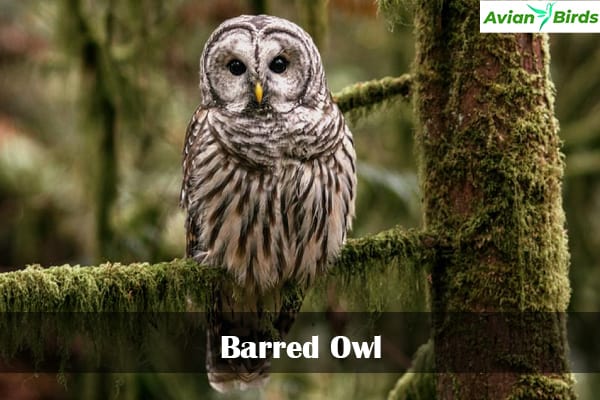
Recognizable Calls and Sounds
Vocalization is crucial for Barred Owls. Their calls help them mark their territory and find mates. We can hear these sounds both day and night, showing they’re there even when we can’t see them.
Their calls help them connect with other owls nearby.
Feeding Habits and Prey
Barred Owls are versatile predators. They eat small mammals like mice and voles, and also birds. This shows they can live in many places in Indiana.
Watching them eat shows how they adapt to what’s available, helping them survive in different places.
6. Eastern Screech-Owl
- Scientific name: Megascops asio
- Life span: 8 to 10 years
- Size: 16 to 25 cm
- Weight: 121 to 244 g
- Wingspan: 46 to 61 cm
The Eastern Screech-Owl is a bird with unique features and a knack for adapting to different places. By looking at their color changes and how they live in cities, we learn more about them. This helps us identify them better and appreciate their amazing nature.

Color Variations and Identification
This small owl has two main color types: red and gray. These colors help them hide in their homes. To spot them, look for:
- Size: About 6 to 10 inches tall.
- Facial disc: A round, noticeable face with yellow eyes.
- Ear tufts: Feather tufts that can be more or less visible.
- Color patterns: Feathers that look like tree bark.
Adaptation to Urban Environments
The Eastern Screech-Owl is great at living in cities. They make the most of their surroundings by nesting in:
- Tree cavities: Safe spots in tree holes.
- Man-made structures: They like attics and other hidden spots in buildings.
These owls live close to us and help control pests. They show how well they can adapt and live in busy places. This makes the Eastern Screech-Owl a true success in today’s world.
| Feature | Red Morph | Gray Morph |
|---|---|---|
| Color | Rich reddish-brown | Gray and white |
| Camouflage Ability | Works well in wooded areas | Works well in shaded areas |
| Common Nesting Sites | Tree cavities | Attics in cities |
| Hunting Strategy | Perch and ambush | Stalking |
Related Video:
7. Long-eared Owl
- Scientific name: Asio otus
- Life span: 10 to 27 years
- Size: 31 to 40 cm
- Weight: 160 to 435 g
- Wingspan: 86 to 102 cm
The Long-eared Owl is a fascinating bird known for its unique traits. It’s especially interesting in how it behaves and communicates with others. These owls often live in small groups, especially when they’re looking for a mate. They form strong bonds with each other by making sounds.

Social Behavior and Communication
Long-eared Owls are not alone in the wild. They talk to each other using different sounds. These sounds help them find mates and stay together in their group. The soft hoots and calls fill the woods, showing how connected these birds are.
Threats and Conservation Status
Even though they’re not in danger, Long-eared Owls face many challenges. Humans are the main threat, mainly because of losing their homes to cities and cutting down trees. To help, conservation efforts aim to save their living spaces. Things like restoring their habitats can make sure these owls keep living in Indiana’s woods.
8. Snowy Owl
- Scientific name: Bubo scandiacus
- Life span: 10 to 28
- Size: 52.5 to 64 cm
- Weight: 1706 to 2426 g
- Wingspan: 146 to 183 cm
The Snowy Owl is a sight to behold with its stunning looks and interesting ways. It’s known for its white feathers and dark spots. These owls live in open areas and like to sit high to watch around them.

Stunning Appearance and Behavior
The Snowy Owl’s look is truly unique. Its feathers seem almost white, standing out in snowy places. Adults look mostly white, but young ones have more dark spots and are browner.
Snowy Owls are active during the day, which is rare for owls. They hunt small mammals like lemmings and rodents. Watching them hunt shows how they’ve adapted to survive. They have great eyesight and can fly quietly, making them top predators.
Common Habitats of Indiana Owls
Owls in Indiana live in different places, each supporting a variety of owl species. You can find them in:
- Forested areas where they nest in tree cavities
- Open fields and grasslands provide hunting grounds
- Urban environments that offer unique nesting opportunities
Owls are very adaptable, living in both natural and human-made environments. They do well where there is plenty of food, helping them to thrive in Indiana. Understanding their habitats helps us see why it’s important to protect Indiana’s nature.
Check Our Previous Articles:
| Learn About the White-Naped Crane |
| Mandarin Duck: Everything You Need To Know |
| Demoiselle Crane | A Guide |
| Black-Headed Duck: Unique Waterfowl of South America |
| Red-Breasted Goose (ID Guide) |
Wrapping Up…
The eight Indiana owl species show a wide variety that makes our ecosystems richer. Each bird plays a key role in keeping nature in balance. From the big Great Horned Owl to the small Northern Saw-whet Owl, they all add something special to our world.
We invite you to connect with these amazing Indiana owls and their homes. Seeing them in the wild can teach us a lot about wildlife. Supporting efforts to save these birds means we can keep enjoying their beauty and mystery for a long time.

